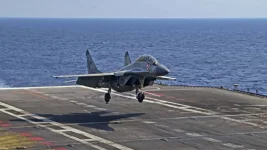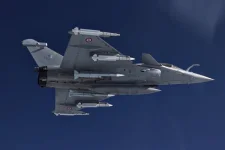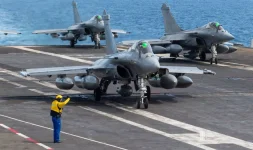- Views: 2K
- Replies: 5
India's domestically developed aircraft carrier, INS Vikrant, which was commissioned in September 2022 and is designed to operate MiG-29K and the indigenous LCA Navy aircraft, is now being prepared for the potential integration of the advanced Rafale-M fighter jet. This move aims to significantly bolster the Indian Navy's air power.
However, successful integration necessitates specific alterations to both the French-made Rafale-M aircraft and the carrier's existing infrastructure to ensure full compatibility and operational efficiency. These adjustments are particularly crucial for the aircraft's fitment on INS Vikrant’s elevators and for optimizing its performance on the carrier, which utilizes a ski-jump for launching aircraft.
A key challenge lies with INS Vikrant’s aircraft elevators, which were initially sized for the somewhat smaller MiG-29K and LCA Navy aircraft. The Rafale-M, possessing a larger wingspan (10.90 m) and overall dimensions (length 15.30 m, height 5.30 m), requires modifications to these lifts to be accommodated.
"The lifts would need some modifications for the Rafale-M to fit in," a defence source stated, highlighting the importance of these systems that are essential for transporting aircraft and equipment between the hangar deck and the flight deck.
To resolve the elevator compatibility issue, a proposed solution involves the removal of the Rafale-M’s wing pylons – external mounting points for weapons or fuel tanks – before the aircraft is moved onto the elevator.
While described as a straightforward procedure taking only a few minutes, it will necessitate careful planning and precise execution to maintain the high tempo of operations typically required on an aircraft carrier. This measure will ensure the jet conforms to the spatial limitations of the lifts, enabling smooth transit between the carrier’s decks.
Beyond the elevators, the ski-jump configuration of INS Vikrant, a Short Take-Off But Arrested Recovery (STOBAR) system, presents another area requiring adjustments for the Rafale-M. This system, which aids aircraft in becoming airborne by providing an upward ramp, is currently optimised for the MiG-29K and LCA Navy.
Unlike aircraft carriers equipped with catapult launch systems (CATOBAR), which provide an assisted launch, Vikrant's ski-jump requires specific adaptations to the Rafale-M's takeoff and landing characteristics for optimal performance.
"As the Indian carriers use a ski-jump, the overall system would also need some changes," the source confirmed. Ski-jumps allow aircraft to take off at lower speeds than from a flat deck but can impose limitations on maximum take-off weight, potentially affecting fuel and armament loads.
These necessary adaptations for the Rafale-M may involve fine-tuning its landing gear to withstand the specific stresses of ski-jump launches and arrested recoveries, as well as adjusting thrust parameters and flight control systems to align with the carrier's launch dynamics.
Furthermore, minor modifications to the flight deck itself could be needed. This might include reinforcing certain sections to handle the Rafale-M's operational weight (maximum take-off weight of 24.5 tonnes) and landing impacts, or recalibrating the arrestor gear systems responsible for halting the aircraft upon landing.
While these modifications to the elevators and flight deck systems are considered relatively minor in engineering terms, they underscore the critical need for meticulous planning and precise execution to achieve seamless compatibility between the aircraft and the carrier.
The Indian Navy is expected to work closely with Dassault Aviation, the manufacturer of the Rafale-M, to prioritise and expedite these changes. This collaboration will be key to ensuring that the integration of the Rafale-M enhances INS Vikrant's combat capabilities without compromising its operational readiness.
India recently finalised a deal with France for the procurement of 26 Rafale-M jets, with deliveries anticipated to commence around mid-2028 and conclude by 2030.
This acquisition is seen as a significant step in modernising the Indian Navy's air arm, particularly as it provides commonality with the Indian Air Force's existing fleet of Rafale fighters, potentially streamlining logistics, maintenance, and training.



